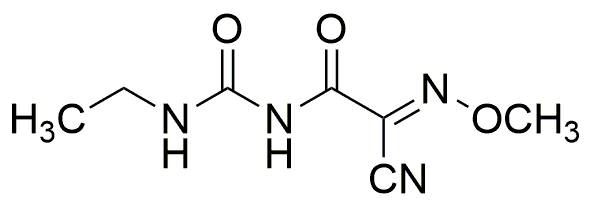Cymoxanil is widely utilized in research focused on:
- Agriculture: This compound serves as a fungicide, effectively controlling various fungal diseases in crops, which helps improve yield and quality.
- Plant Protection: It is particularly beneficial in protecting vegetables like potatoes and tomatoes from late blight, ensuring healthier produce for consumers.
- Integrated Pest Management: Cymoxanil is often used in combination with other pesticides, enhancing the effectiveness of pest control strategies while minimizing environmental impact.
- Research and Development: Scientists utilize this chemical to study plant-pathogen interactions, contributing to the development of more resilient crop varieties.
- Regulatory Compliance: Its use in agriculture is supported by regulatory bodies, ensuring that it meets safety standards for both human health and environmental protection.
General Information
Properties
Safety and Regulations
Applications
Cymoxanil is widely utilized in research focused on:
- Agriculture: This compound serves as a fungicide, effectively controlling various fungal diseases in crops, which helps improve yield and quality.
- Plant Protection: It is particularly beneficial in protecting vegetables like potatoes and tomatoes from late blight, ensuring healthier produce for consumers.
- Integrated Pest Management: Cymoxanil is often used in combination with other pesticides, enhancing the effectiveness of pest control strategies while minimizing environmental impact.
- Research and Development: Scientists utilize this chemical to study plant-pathogen interactions, contributing to the development of more resilient crop varieties.
- Regulatory Compliance: Its use in agriculture is supported by regulatory bodies, ensuring that it meets safety standards for both human health and environmental protection.
Documents
Safety Data Sheets (SDS)
The SDS provides comprehensive safety information on handling, storage, and disposal of the product.
Product Specification (PS)
The PS provides a comprehensive breakdown of the product’s properties, including chemical composition, physical state, purity, and storage requirements. It also details acceptable quality ranges and the product's intended applications.
Certificates of Analysis (COA)
Search for Certificates of Analysis (COA) by entering the products Lot Number. Lot and Batch Numbers can be found on a product’s label following the words ‘Lot’ or ‘Batch’.
*Catalog Number
*Lot Number
Certificates Of Origin (COO)
This COO confirms the country where the product was manufactured, and also details the materials and components used in it and whether it is derived from natural, synthetic, or other specific sources. This certificate may be required for customs, trade, and regulatory compliance.
*Catalog Number
*Lot Number
Safety Data Sheets (SDS)
The SDS provides comprehensive safety information on handling, storage, and disposal of the product.
DownloadProduct Specification (PS)
The PS provides a comprehensive breakdown of the product’s properties, including chemical composition, physical state, purity, and storage requirements. It also details acceptable quality ranges and the product's intended applications.
DownloadCertificates of Analysis (COA)
Search for Certificates of Analysis (COA) by entering the products Lot Number. Lot and Batch Numbers can be found on a product’s label following the words ‘Lot’ or ‘Batch’.
*Catalog Number
*Lot Number
Certificates Of Origin (COO)
This COO confirms the country where the product was manufactured, and also details the materials and components used in it and whether it is derived from natural, synthetic, or other specific sources. This certificate may be required for customs, trade, and regulatory compliance.

